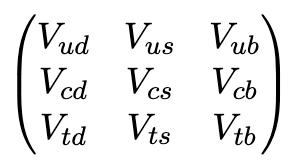FLAG, i.e., the Flavour Averaging Lattice Group, is a collaboration of scientists who generally also have primary employment elsewhere (much like the Particle Data Group) that compiles and analyzes experimental results in lattice QCD and updates these results periodically, to determine the bottom line values of Standard Model fundamental physical constants and also the experimentally measured values of a variety of other physical constants that could in principle be calculated from first principles in the Standard Model.
FLAG is generally more bold in terms of reaching precise values for constants, by being willing to be less methodology and outlier agnostic than the Particle Data Group.
Some select results
* Quark masses (in the MS bar scheme in a 2+1+1 scheme, at pole mass for bottom and charm quarks and a 2 GeV energy scale for the three light quark masses, followed by comparable PDG estimates):
u quark mass: 2.14 ± 0.18 MeV v. 2.16 ± 0.07 MeV
d quark mass: 4.70 ± 0.05 MeV v. 4.70 ± 0.07 MeV
s quark mass: 93.44 ± 0.68 MeV v. 93.5 ± 0.8 MeV
c quark mass: 1280 ± 12 MeV v. 1273.0 ± 4.6 MeV
b quark mass: 4200 ± 14 MeV v. 4183 ± 7 MeV
* CKM matrix elements from global Standard Model fits:
|V(ud)|: 0.97439(14)
|V(us)|: 0.22483(61)
|V(ub)|: 0.00382(24)
* The strong force coupling constant alpha(s) in a five quark model in the MS bar scheme at the Z boson mass:
0.1183(7)
Combining FLAG and PDG non-lattice estimates:
0.1181(7)
Electron mass 0.051099895000 ± 0.00000000015 MeV
Muon mass 105.6583755 ± 0.0000023 MeV
Tau lepton mass 1,776.93 ± 0.09 MeV
Z boson mass 91,188 ± 2 MeV
SM Higgs boson mass 125,200 ± 110 MeV
Citation details are below the fold.
Their 2024 annual report, which is 435 pages long, is now available. The abstract is as follows:
We review lattice results related to pion, kaon, D-meson, B-meson, and nucleon physics with the aim of making them easily accessible to the nuclear and particle physics communities. More specifically, we report on the determination of the light-quark masses, the form factor f(+)(0) arising in the semileptonic K→π transition at zero momentum transfer, as well as the decay-constant ratio f(K)/f(π) and its consequences for the CKM matrix elements V(us) and V(ud).
We review the determination of the B(K) parameter of neutral kaon mixing as well as the additional four B parameters that arise in theories of physics beyond the Standard Model.
For the heavy-quark sector, we provide results for m(c) and m(b) as well as those for the decay constants, form factors, and mixing parameters of charmed and bottom mesons and baryons. These are the heavy-quark quantities most relevant for the determination of CKM matrix elements and the global CKM unitarity-triangle fit.
We review the status of lattice determinations of the strong coupling constant α(s).
We review the determinations of nucleon charges from the matrix elements of both isovector and flavour-diagonal axial, scalar and tensor local quark bilinears, and momentum fraction, helicity moment and the transversity moment from one-link quark bilinears.
We also review determinations of scale-setting quantities.
Finally, in this review we have added a new section on the general definition of the low-energy limit of the Standard Model.


1 comment:
tics review articles
article
Review Article
Published: 05 November 2024
A history of multiple Denisovan introgression events in modern humans
Linda Ongaro & Emilia Huerta-Sanchez
Nature Genetics (2024)Cite this article
779 Accesses
70 Altmetric
Metrics details
Abstract
The identification of a new hominin group in the Altai mountains called Denisovans was one of the most exciting discoveries in human evolution in the last decade. Unlike Neanderthal remains, the Denisovan fossil record consists of only a finger bone, jawbone, teeth and skull fragments. Leveraging the surviving Denisovan segments in modern human genomes has uncovered evidence of at least three introgression events from distinct Denisovan populations into modern humans in the past. Each of them presents different levels of relatedness to the sequenced Altai Denisovan, indicating a complex relationship between these sister lineages. Here we review the evidence suggesting that several Denisovan populations, who likely had an extensive geographical range, were adapted to distinct environments and introgressed into modern humans multiple times. We further discuss how archaic variants have been affected by demographic history, negative and positive selection and close by proposing possible new lines of future research.
Post a Comment